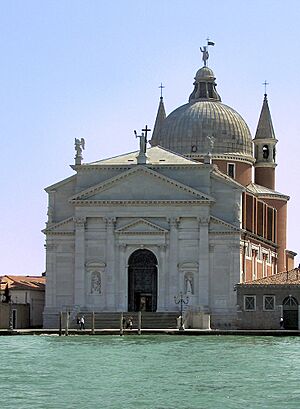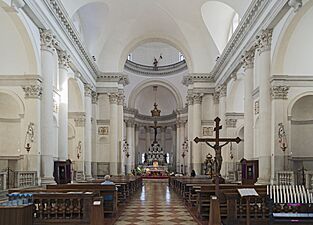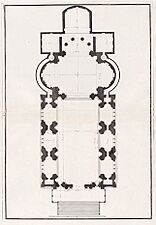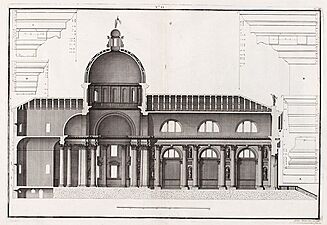Il Redentore facts for kids
Quick facts for kids Chiesa del Santissimo RedentoreChurch of the Most Holy Redeemer |
|
|---|---|

Il Redentore on the island Giudecca
|
|
| 45°25′29.97″N 12°19′56.83″E / 45.4249917°N 12.3324528°E | |
| Location | Venice |
| Country | Italy |
| Denomination | Roman Catholic |
| History | |
| Status | Active |
| Consecrated | 1592 |
| Architecture | |
| Architect(s) | Andrea Palladio |
| Architectural type | Church |
| Style | Renaissance |
| Groundbreaking | 1577 |
| Completed | 1592 |
| Specifications | |
| Length | 75 metres (246 ft) |
| Width | 30 metres (98 ft) |
| Nave width | 20 metres (66 ft) |
The Chiesa del Santissimo Redentore (which means "Church of the Most Holy Redeemer" in English), often called Il Redentore, is a famous church from the 1500s. It is a Roman Catholic church located on the Giudecca island in Venice, Italy.
A famous Italian architect named Andrea Palladio designed it. The church was built to thank God for saving the city from a terrible sickness called the plague. It stands right on the waterfront of the Canale della Giudecca. This makes it a very noticeable building on the Giudecca island. Il Redentore is part of the Chorus Association of Venetian churches. It holds many beautiful paintings by artists like Tintoretto and Paolo Veronese.
Contents
History of Il Redentore Church
Why Was Il Redentore Built?
Il Redentore was built as a special "votive" church. This means it was a gift or promise made to God. It was built to give thanks for the end of a terrible plague. This sickness hit Venice very hard between 1575 and 1576. About 46,000 people, which was a huge part of the city's population, died.
The leaders of Venice, called the Venetian Senate, asked the architect Andrea Palladio to design this important church. Even though the Senate wanted a square church, Palladio designed one with a long main hall (nave). It also had three small chapels on each side.
Palladio's Design and Special Steps
The church's location on the Canale della Giudecca was perfect. It allowed Palladio to design a grand front (facade) inspired by the ancient Pantheon in Rome. He placed the church on a wide platform. To reach the entrance, people had to climb 15 steps. This was a special number. It was a direct reference to the ancient Temple of Jerusalem. Palladio believed that climbing these steps slowly would help people feel more religious.
Building and Consecration
The first stone of the church was laid on May 3, 1577. A church leader from Venice, Giovanni Trevisan, led the ceremony. The building was officially finished and blessed in 1592. After it was blessed, the church was given to a group of monks called the Order of Friars Minor Capuchin. A few of these monks still live in the monastery next to the church today.
The Festa del Redentore Celebration
Every year, the leader of Venice, called the doge, and other important senators would walk to the church. They crossed a special pontoon bridge built just for the occasion. This bridge stretched from the Zattere area to Giudecca island. They would attend a special Mass (church service) there.
This tradition continues today with the Festa del Redentore. It is a very important festival in Venice. It happens on the third Sunday in July. The night before, there is a huge firework display. This is followed by a large procession of people walking across the pontoon bridge to the church.
Recent Events at the Church
In May 2022, the church's front was painted with pink paint. This act of vandalism caused damage to a part of the church's facade. Local people tried to clean it, but the paint soaked into the stone. Now, government art experts are working to restore the church.
Exterior of Il Redentore
A Landmark Design
Il Redentore stands in one of the most important spots for any building designed by Palladio. Many people think it is one of his best works. It is a large, white building. It has a beautiful dome on top, which is crowned with a statue of the Redeemer.
On the front of the church, there are two triangular shapes called pediments. A smaller one sits on top of a larger, lower one. This classic design reminds us of Palladio's work on another church, San Francesco della Vigna. There, he used a design similar to a triumphal arch.
Palladio's Use of Geometry
Palladio was famous for using exact geometric shapes in his building designs. The front of Il Redentore is a great example. The total height of the church is four-fifths of its total width. Also, the width of the central part is five-sixths of its height. This shows how carefully Palladio planned his buildings.
Some people also think there are influences from Eastern architecture in the church's exterior. This is especially true for the two bell towers, called campanili, which look a bit like minarets.
Interior of Il Redentore
Inside the Church
Since Il Redentore was a pilgrimage church, it needed a long main hall, or nave. This was a bit tricky for Palladio, who loved classical architecture. The inside of the church is a mix of styles. It has white stucco (a type of plaster) and gray stone. The long nave connects to a domed area in the middle, called a crossing. These spaces are clearly separate but also flow together smoothly. A continuous line of Corinthian order columns runs all around the inside.
Art Work Inside Il Redentore
Il Redentore is home to many important paintings. You can see works by artists such as Francesco Bassano, Carlo Saraceni, Leandro Bassano, Palma the Younger, Jacopo Bassano, Paolo Veronese, and the workshop of Tintoretto.
The church has also been painted many times by famous artists. For example, Canaletto painted Il Redentore several times. One of his paintings is now kept at Woburn Abbey in England.
Gallery
See also
- History of early modern period domes
- List of buildings and structures in Venice
- List of churches in Venice






